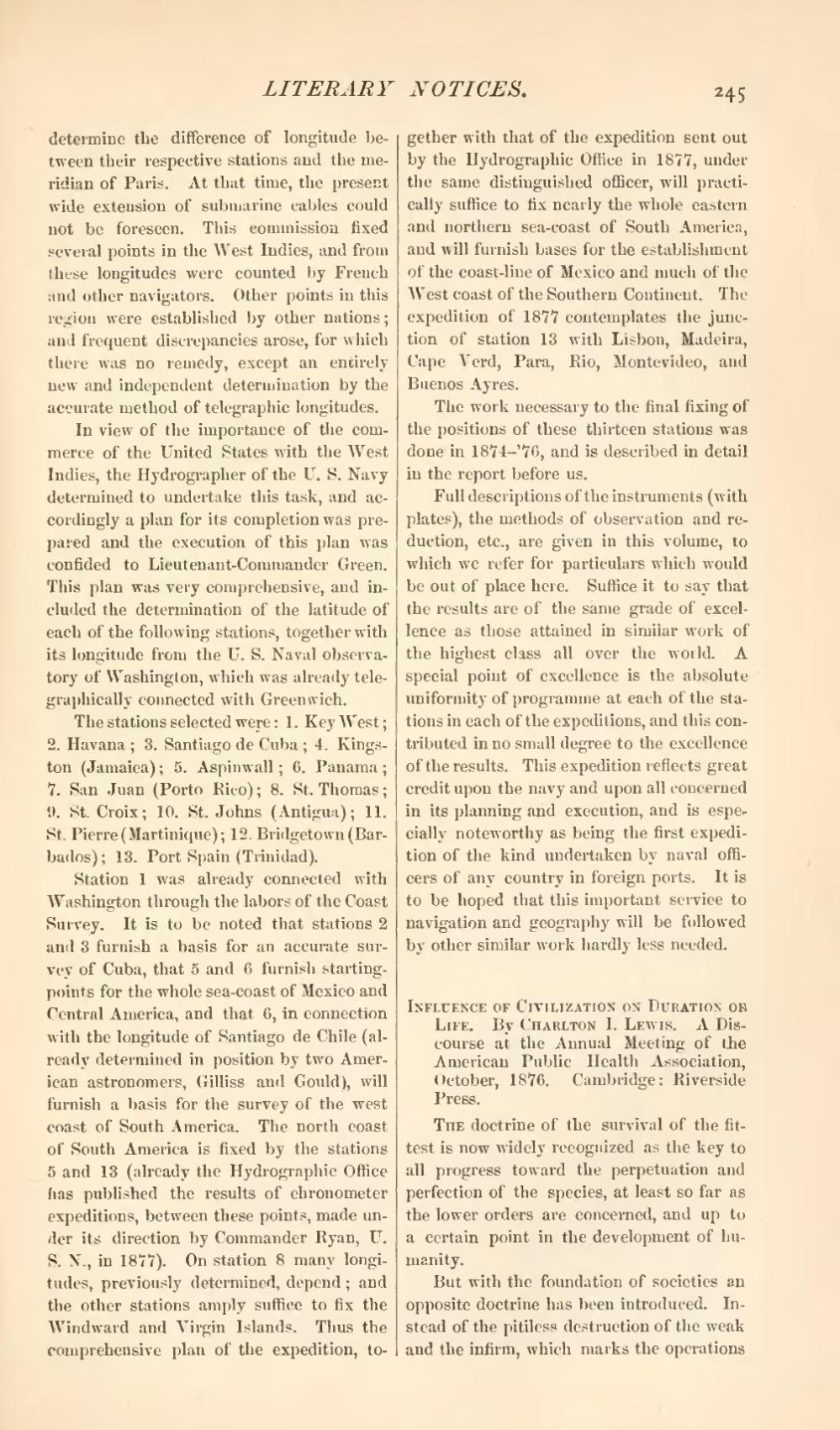determine the difference of longitude between their respective stations and the meridian of Paris. At that time, the present wide extension of submarine cables could not be foreseen. This commission fixed several points in the West Indies, and from these longitudes were counted by French and other navigators. Other points in this region were established by other nations; and frequent discrepancies arose, for which there was no remedy, except an entirely new and independent determination by the accurate method of telegraphic longitudes.
In view of the importance of the commerce of the United States with the West Indies, the Hydrographer of the U.S. Navy determined to undertake this task, and accordingly a plan for its completion was prepared and the execution of this plan was confided to Lieutenant-Commander Green. This plan was very comprehensive, and included the determination of the latitude of each of the following stations, together with its longitude from the U. S. Naval observatory of Washington, which was already telegraphically connected with Greenwich.
The stations selected were: 1. Key West; 2. Havana; 3. Santiago de Cuba; 4. Kingston (Jamaica); 5. Aspinwall; 6. Panama; 7. San Juan (Porto Rico); 8. St. Thomas; 9. St. Croix; 10. St. Johns (Antigua); 11. St. Pierre (Martinique); 12. Bridgetown (Barbados); 13. Port Spain (Trinidad).
Station 1 was already connected with Washington through the labors of the Coast Survey. It is to be noted that stations 2 and 3 furnish a basis for an accurate survey of Cuba, that 5 and 6 furnish starting points for the whole sea-coast of Mexico and Central America, and that 6, in connection with the longitude of Santiago de Chile (already determined in position by two American astronomers, Gilliss and Gould), will furnish a basis for the survey of the west coast of South America. The north coast of South America is fixed by the stations 5 and 13 (already the Hydrographic Office has published the results of chronometer expeditions, between these points, made under its direction by Commander Ryan, U. S. N., in 1877). On station 8 many longitudes, previously determined, depend; and the other stations amply suffice to fix the Windward and Virgin Islands. Thus the comprehensive plan of the expedition, together with that of the expedition sent out by the Hydrographic Office in 1877, under the same distinguished officer, will practically suffice to fix nearly the whole eastern and northern sea-coast of South America, and will furnish bases for the establishment of the coast-line of Mexico and much of the West coast of the Southern Continent. The expedition of 1877 contemplates the junction of station 13 with Lisbon, Madeira, Cape Verd, Para, Rio, Montevideo, and Buenos Ayres.
The work necessary to the final fixing of the positions of these thirteen stations was done in 1874-'76, and is described in detail in the report before us.
Full descriptions of the instruments (with plates), the methods of observation and reduction, etc., are given in this volume, to which we refer for particulars which would be out of place here. Suffice it to say that the results are of the same grade of excellence as those attained in similar work of the highest class all over the world. A special point of excellence is the absolute uniformity of programme at each of the stations in each of the expeditions, and this contributed in no small degree to the excellence of the results. This expedition reflects great credit upon the navy and upon all concerned in its planning and execution, and is especially noteworthy as being the first expedition of the kind undertaken by naval officers of any country in foreign ports. It is to be hoped that this important service to navigation and geography will be followed by other similar work hardly less needed.
Influence or Civilization on Duration on Life. By Charlton I. Lewis. A Discourse at the Annual Meeting of the American Public Health Association, October, 1876. Cambridge: Riverside Press.
The doctrine of the survival of the fittest is now widely recognized as the key to all progress toward the perpetuation and perfection of the species, at least so far as the lower orders are concerned, and up to a certain point in the development of humanity.
But with the foundation of societies an opposite doctrine has been introduced. Instead of the pitiless destruction of the weak and the infirm, which marks the operations
